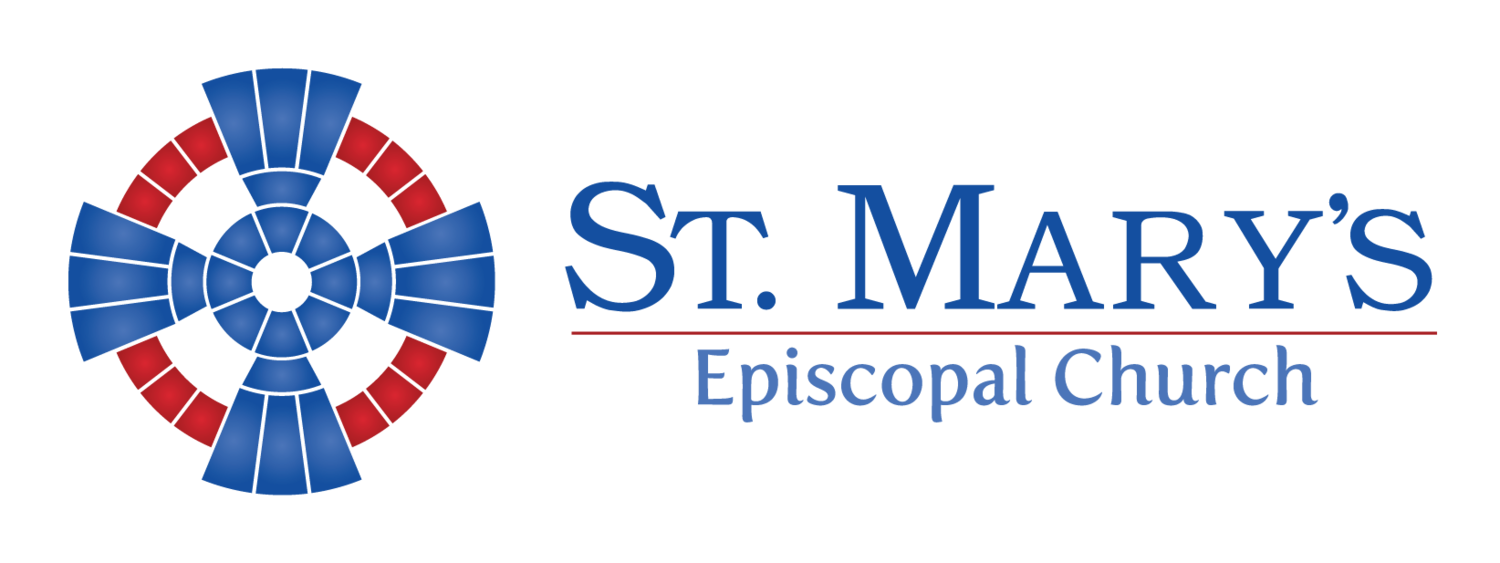The Year of Mary - A Sermon from Circle Service
This past Wednesday was the Feast of the Assumption of Mary, celebrating the bodily taking up of Mary into heaven at the end of her life on earth. Here at St. Mary’s we celebrate this as the Feast of Mary.
The preparation for this sermon began last fall when my friend Erica and I decided we wanted to work together for a year on women’s spiritual events focusing on Mary. This resulted in the Advent half-day retreat Waiting with Mary, and six months of preparing for and leading the June women’s weekend retreat, Walking with Mary.
We high-fived on the street outside my house and gleefully declared last year “The Year of Mary.” We spent an enormous amount of time studying, meditating, and writing about Mary. It was a rich and rewarding project. However, the journey raised many more questions than answers, and the questions continue to disturb me.
Getting deeper into Mary is upsetting because her story has been almost completely silenced and co-opted by the institution of the Church. She has been used as a model of submission, piety, and purity, when in fact she was probably a woman of great courage, intelligence, and power, as evidenced in the person Jesus was.
Getting deeper into Mary is upsetting because the silencing and sanitizing of her story looks too much like the silencing of my own story, and the tremendous pressure I have felt all my life to be a good girl, to be a model of submission, piety, and purity.
Increasingly I am realizing that although I cannot resurrect the entirety of Mary’s story, I can do what is in my power to do, and that is to honestly share my story as a woman of faith, and encourage all of you to do the same. To share the real stories, even if they upset the status quo.
The story I am going to share with you today starts with this Circle. This is where the ancient Blessed Mother broke through in a living way for me, in the life-giving safety of this Circle.
Circle Service was started eighteen years ago this summer by a group of brave women who passionately wanted several things: inclusive language (language about the Divine that did not alienate anyone), shared power (symbolized by our arrangement as equals in this circle), and to create a place where people could honestly wrestle with their beliefs and experience of the Divine.
This Circle movement, I will call it—it’s bigger than just a weekly service—is labeled “alternative,” but it is also firmly rooted in real tradition. It is deeply Christian, and it is authentically Episcopalian. In the Circle Movement there is room for the full range of doubt and confusion and disagreement. There is room for all the good stuff too, the stuff we can agree on, but the “alternative” status is specifically for making room for the hard stuff.
I am a feminist, meaning, I believe in and work towards wholeness for each human person. “In Christ there is no male or female,” as St. Paul says. In my body, my deepest heart, my spirituality is earth-based. My ancestors are my teachers, and they work through creation. When I ask a sincere question of a tree, for example, I am given an answer.
I am a Christian because I love Jesus. I know that Jesus is one with the Divine, and that the Divine speaks directly to me through him. I believe that we as a community, the people of God, are empowered to transform these creatures here, the bread and wine on this table, into the spiritual food we need to become the living body of Christ in the world.
I was raised Catholic, so I was steeped in Mary. I am named after her. I grew up in the Cathedral of the Blessed Virgin Mary. My family always sat on the Mary side of the church, the left side, which had an alcove with a statue of Mary. From the time I was tiny, and the mass was still in Latin, and up until only a few years ago, I studied that same statue and wondered: Who are you really?
Through a long period, around when I was the age of Saint Bernadette of Lourdes, I waited for Mary to speak to me special. Bernadette was 14 when Mary appeared to her. About the age Mary was, when the angel visited her, by the way. I would sit in front of the statue, and long for her to speak. She did not speak.
Who was Mary? Mary was certainly a historical person, because Jesus existed, and he had a mother. The story of Jesus in the gospel of Luke begins with Mary, when the angel tells her she’s pregnant with him. The Magnificat that we read together today for the Gospel was what she says when she meets her cousin Elizabeth, who was John the Baptist’s mother.
In the Bible, Mary is given only 191 words. It takes the average person about one minute to speak 120 words, so Mary speaks for only about a minute and a half total.
The most words she speaks at one time are in the Magnificat, a hymn that reveals very little about her as a person except that, like a good girl, she is grateful to the Almighty. Mary is a handmaiden of the Lord, a servant. It’s a beautiful, powerful hymn, and it tells us a lot about God, but it tells us almost nothing about Mary as a human woman.
Mary speaks 191 words in the Bible. During our 6-month preparation for the women’s retreat, my leadership team and I did Lectio Divina, an ancient Benedictine practice of meditating on sacred texts. Over the months, we deeply pondered every single word Mary said, and shared what was rising in each of us in response.
I have to tell you, as the months went by, I became more and more disturbed. Who is this very important woman? The mother of the man who has changed the course of history? I became more and more convinced that the words attributed to her were not her words, but the words the forming church wanted her to have.
The deeper story of Mary is ancient, deeply ancient, much older than Christianity. The deeper story of Mary is written on my heart, and yours, and deep in the unfolding story of what it means to be human.
Dr. Clarissa Estes is an indigenous Jungian psychologist and storyteller who went on an interesting quest related to Mary. She traveled the world and asked indigenous people on every continent about the Blessed Mother, Our Lady, Mary, and she found a version of Mary everywhere and adapted to every single circumstance. Judy did some research for the women’s retreat on Mary and found that there are dozens and dozens of names for Mary the world over, all of them seen as perfectly legitimate names for Mary. This is what Estes found as well, on her quest.
For example, if for the local people, some road was the most important thing, the road was where people dried and sorted the harvest and met one another for trysts, the road was the central symbolic identity of the place, then Mary became something like, Our Lady of the Road. In many places, Mary is known as Queen of Heaven, which was also a name used for the ancient African goddess Isis, whose flower, by the way, was the rose.
And so, my brothers and sisters: Maybe today I’ve found a new name for Mary: Our Lady of the Circle. Maybe this is how she speaks to me today. As our opening chant says,
Long before the name of a God was spoken
Long before a cross was nailed from a tree
Long before She laid her arm of colors ‘cross the sky
there was a love,
this ancient love was born.
The story of Mary is an ancient story of love. The story of Mary is written on my heart, and yours. And it matters very much that it is NOT written in our holy texts, or in our liturgical prayers. The silence is wrong, and distorts our understanding of ourselves as whole human beings.
I will close by reading part of the dedication in an important book by Episcopal priest Lindsay Hardin Freeman, Bible Women: All Their Words and Why They Matter, published in partnership with Episcopal Church Women.
Dedicated to all women and girls
who have spoken, screamed, or cried
whose words were not remembered or understood
and to those who could not speak
who were silenced, beaten back
their cries known to You alone.
Restore them, Lord—Our Lady of the Circle,
renew them, make them whole,
on earth, as it is in heaven.
Amen.








